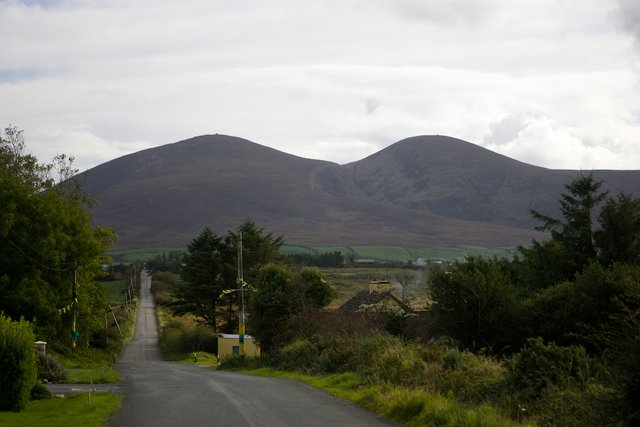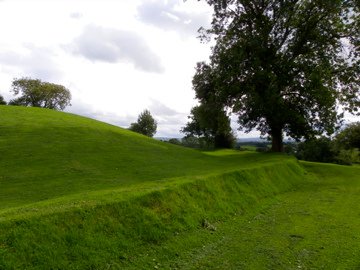Ireland and The Morrigan: Joining of the Sacred Feminine And Nature


INTRODUCTION
The history of Ireland is very unique. Due to the isolated geography of the land, their ancient culture is well preserved. It wasn’t until the fifth century C.E. that outsiders made a big impact on Irish beliefs; before then, Ireland had remained “relatively untouched” (Rowley, 1997).

One fascinating feature of Irish culture is their mythology, particularly in relation to the feminine divine. Before Christianity, the Irish believed in the presence of many gods. These gods of Ireland are called The Tuatha De Dannan which translates into “People of the Goddess Danu”. People believed that these gods had once lived on Ireland. This discussion focuses on one particular goddess from this tribe called the Morrigan, whose name translates into “Great Queen”.
Any pronouns referring to the Morrigan will be capitalized to acknowledge Her sacredness. The Morrigan is most famously known for being a Goddess of War. However, She is a complex deity and also plays a very important role as a Goddess of the Land among others. She was so important that the Irish felt compelled to name natural landmarks after Her. For example, in the County Meath there are a pair of hills that have been given the name Da Chich na Morrigna, or the Two Breasts of the Morrigan.
When nature is seen as being sacred, it encourages people to take care and honor it. We look to explore the significance of female divinity and its connection to the natural world as well as the landmarks of Ireland and how they might have affected people’s dignity.
The procedures used to gather information for this discussion involved journal articles, books, old Irish tales recorded by Christian scribes, as well as an Irish radio talk show.
Journal articles containing information about Ireland’s mythology and natural landscape were gathered. One article focused on the feminine divine in Ireland’s mythology and folklore while the other focused specifically on the Morrigan. Another written source used was a well-researched book by Stephanie Woodfield. Woodfield is a minister at the Universal Life Church and has closely studied Celtic mythology. The book in its entirety is about the origins, mythology, and history of the Morrigan. Much of the information for this study was taken from the chapter 9, Earth Mother.
The Irish passed their traditions and stories down orally for thousands of years. It wasn’t until Christianity came to the island that their lore was written down. They were written down as poetry and prose narratives. The Dindshenchas is a collection of short stories and poems that tell of the spiritual and cultural importance of Ireland’s many landscapes. The Mythological Cycle tells of the origins of the land, people, and gods. The Ulster Cycle speaks of tales about heroes and kings. Although these stories were written through the biased lens of Christianity, they felt the need to preserve at least the general stories of Ireland’s folklore. One issue that arises from using these stories is that they were written in early Irish languages which varied depending on the time causing faulty translations. To this day, there are written pieces that have not been translated while other translations are disputed among scholars. The Morrigan played an important role in Ireland’s mythological history and was a reoccurring deity. There are poems that are spoken through Her perspective.
Lastly, Story Archaeology is a podcast hosted by Chris Thompson and Isolde Carmody. Since 1998 they have been having discussions about Irish stories. Carmody has a Masters in Early Irish. Thompson has a post-graduate diploma in educational drama and has a strong passion for stories of Ireland. Throughout this podcast they explore the traditional tales in great detail. The Morrigan has a presence in several of the stories and poems they discussed with a few podcasts specifically about the Morrigan.

Women and the Environment
It has been observed that the interaction between Nature and women leads to sustainability as they are the ones interacting with the natural world the most. This is not a new observation, as women have been connected with Nature for thousands of years. There is an indivisible relationship between the sacred feminine and Earth.
Despite Her popularization as a War and Death goddess, the Morrigan was originally a Goddess of the Land and Sovereignty. She is seen as being the embodiment of Earth itself. The connection can be found in several places. She is said to be the daughter of Ernmas, a goddess of fertility and agriculture. Earth goddesses were actually not uncommon. For instance, the Tuatha are children of Danu who is a goddess of the river and bodies of water.
To the ancient Irish, the Earth was sacred. Every aspect of it was honored in some way. Water, for instance, was said to hold “mystic quality” (Woodfield, 2011). They were able to observe that the water held healing properties of sorts as it was able to keep their crops fertilized. They understood that in order to live a sustainable life, one had to live in connection with the Earth. Perhaps if more people viewed water as being sacred in modern times, we wouldn’t be so quick to pollute the rivers that bring life.
The Morrigan shows Her connection to the land with Her sacred animals. It was common for female deities to shape-shift into animals that were linked with the Earth. The Morrigan typically appeared as a crow, wolf, raven, horse, eel, or cow. Ireland’s economy depended on cattle, so it would make sense for the Morrigan to hold the cattle as being sacred. For this reason, they weren’t simply slaughtered for food. In fact, cows were so important in Ireland that clans fought wars over them, the Morrigan having started one of them.
Multiplicity of Roles is when a woman can play the victim, activist, or survivor. The Morrigan is the perfect example of this. Her dual personality helped the Irish find balance. It is said that she is “just as likely to take a lover into her arms as she is to take up arms against a lover” (Rowley, 1997). This meant the Irish understood that nature has the ability to nurture and create life, but it also can destroy. Therefore, they knew it would not be wise to upset a goddess of the land.
There are people who would question the juxtaposition of life and death in a single deity; it seems contradictory. However, it was very common for the Irish to pair birth and death together as they are much more closely linked than many realize. It can be seen in how the Morrigan could easily take away just as she could give. This was a form of balance and a way to show how the natural cycle of Nature works.
The Morrigan wasn’t afraid to demand justice. If one is to protect what is held sacred to them, then they should be armed with the necessary weapons to defend. In this instance, if Nature is being attacked, as it is in modern times, then Nature should have the ability to fight back. Those linked with Mother Earth have felt that cry today and have taken up arms to defend Her. It has been said that the next World War will be waged over water.
The Morrigan, like a silent mother letting you fall and get bloody, leaves it up to the people to decide what to do. She gave them warnings, however, in the form of poetry. There are two particular poems that follow the Cath Maige Tuired, an Irish saga text on Irish mythology. The first is a poem in which the Morrigan sees a prosperous land full of life. The contrasting poem speaks of a land ravaged by poverty and despair. One can argue that this is to reflect her nature of balance; however, it can also be seen as a way to warn future generations that their actions have consequences. These poems help us see that the Irish understood the importance of Nature. They would try their best not to bring about harm because there were prophecies from the Morrigan herself showing visions of a gloomy future.

Sacred Geography and Dignity
Every human has some form of self-respect; this is our dignity. A person’s dignity can be affected in interactions with specific settings, people, and attitudes. It is hard to know how individuals felt about their own dignity in ancient Ireland; however, by taking a look at Ireland’s landscapes, one may be able to deduce the dignity of their society at least. Dignity of the Irish can be seen in how they named landmarks after deities. In particular, many landmarks bare the name of the Morrigan in one way or another. They either directly state Her name or She is referred to by another linked name from old Irish literature.

A pair of hills in Meath bares the name Da Chich na Morrigna, or the Breasts of the Morrigan. In the County of Louth there is a place called Gort na Morrigna, or the Morrigan’s Field. Mur na Morrigna, or Mound of the Morrigan, is found in Boyne Valley. The Bed of the Couple is a location near a river that marks the place where the Morrigan mated with another god, the Dagda. Lio Baidbhe, or Badb’s Fort, is another one as Badb is another name for the Morrigan. Emain Macha was the capital of Ulster; Macha is also another name for the Morrigan.

All of these are indicators of how the Irish viewed themselves in relation to the world around them. This must imply that the Irish were humble in regard to Nature and the Morrigan. They felt that this power was greater and more important than they were, so they named landmarks after Her in order to praise Her. Nature was sacred and the Irish were very aware of that.
Another interesting historical tidbit to note is the Irish belief over kingship – the king was never given complete sovereignty over the land. Instead, he was expected only to be a modest representative. When the king took the throne, he was entering into a sacred marriage with the land itself. Any blemish of the king’s was thought to be transferred to the land, so he would have to step down if he was imperfect in any way.
An example of this would be when King Nuada lost his arm; he accepted that his dignity has been stained and stepped down from rule. Although he ended up with a new silver arm according to myth he was inherently flawed now.
In old literature, the Morrigan is seen giving kingship to rightful men by lying with them. This was symbolic of him sleeping with the land and was said to “bring good fortune, victory, and fertility” (Clark, 1987). This kind of relationship made the king’s dignity very important; he had to be careful not to do things that would cause him to look bad as that could also cause him to lose his status and rule.

The Impact of New Age Spirituality

The impact of the Nature-based spirituality has been huge. If New Age spirituality continues to grow, it can be assumed that environmental concern will continue to rise.
Celtic spirituality has been around for thousands of years. In the article Celtic spirituality and contemporary environmental issues, Duncan discusses the “current environmental crisis from a faith perspective and attempts to draw lessons from Celtic traditions of spirituality in a scientific age” (Duncan, 2015). He illuminates the “resilience and durability” of the Celtic tradition; although Christianity has dominated Ireland, the old ways have been revived twice in history through Celtic Christian and New Age spirituality (Duncan, 2015).
An example of this Celtic revival would be communities who honor the old gods and goddesses such as those who follow the Morrigan. It has been found that communities such as these expresses deep concerns for the destruction of the environment. As a consequence, many have turned to protesting and activism in order to reject the unsustainable models that the government and corporations have been following.
There has been an increasing amount of “community-based environmental protests” within the last decade as a result of industrial development (Leonard, 2009). Originally when businesses aimed at providing services, environmental policies were made to regulate pollution and the industry; however, overtime, those policies have been changed to benefit corporations and promote economic growth.
Leonard argues that one problematic issue today is that people are not in contact with the environment which leads to its devaluation. Cities are the most populated places today. Technology is embedded into modern life. Much of the food consumed is pre-packaged and processed. The developed, industrial way of life has completely stripped humanity’s knowledge of the environment to the extent that they don’t realize that every action taken has an impact. The opposite is happening with people living in direct contact with the land. Rural communities are voicing their discontentment with the environmental neglect.

Conclusion
The world goes in phases, transitioning from one era to another. The modern world is now on a tipping point where the humanity’s perspective needs to shift out of the industrial age into a sustainable one. There seems to be a parallel between spiritual beliefs and how people respond to the environment. The New Age spirituality movement is directly impacting the relationship between human and Earth. People are realizing that Earth is a living system and that it needs to be nurtured. The ways of our world are not sustainable and if the same trajectory is followed, the Earth’s environment will continue to decline.
The world’s perspective needs to shift away from the busy, technological world and back to the environment. People need to spend more time in nature so that they can see how their lives are directly connected with it. While it is not necessary – or achievable – for the entire world to gain the same spiritual insight, respect for the environment is a lesson that can be learned by everyone.
By taking a step back to view the world on a macroscale, one may understand their place in the world – just a tiny grain of sand. One person is insignificant compared to Mother Nature, but the combined power of community has the ability to literally change the world.
There is no need proving this.
We have reached the Anthropocene – a new epoch – a new time in history where man’s footprint cannot be denied here on Earth.
Earth does not need us to survive, but we need her to sustain us. It is through the sacred worship of Earth that humans will learn to live sustainably again.

References For Your Curiosity
Clark, R. (1987). Aspects of the Morrigan in early Irish literature. Irish University Review, 17(2). Retrieved from http://www.jstor.org/stable/25477680
Duncan, G. (2015). Celtic spirituality and contemporary environmental issues. HTS Teologiese Studies / Theological Studies, 71(3). Retrieved from http://hts.org.za/index.php/HTS/article/view/2857
Leonard, L. (2009). Social partnership’s boiling point: Environmental issues and social responses to neo-liberal policy in Ireland. Critical Social Policy, 29(2). Retrieved from http://csp.sagepub.com.proxy.library.vcu.edu/content/29/2/279#cited-by
Rowley, S. (1997). The one who is many, the many who are one: Power and potentiality in the sacred females of pre-Christian Ireland. Canadian Woman Studies, 17(1). Retrieved from http://proxy.library.vcu.edu/login?url=http://search.proquest.com/docview/217451892?accountid=14780
Woodfield, S. (2011). Celtic lore & spellcraft of the Dark Goddess: Invoking the Morrigan. Woodbury, MN: Llewellyn Publications
pictures were found on google under 'labeled for reuse'
Really enjoyed the article. I've felt a connection to the Celtic path for a very long time. You have a strong voice for the ancestors...
thank you so much! I'm glad I am able to give them a voice . They sure do deserve it! :)
Nice Post, Amethyst!
Thank you very much!